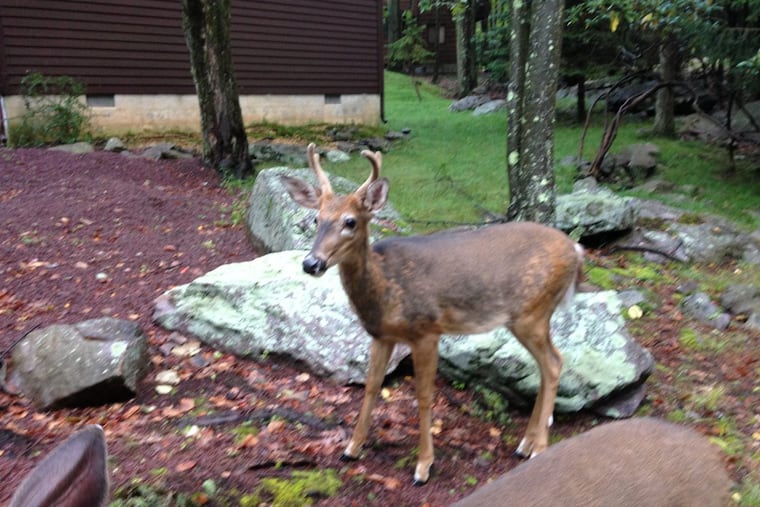Penn State study found COVID-19 in deer and researchers warn Pa. hunters should take precautions
White-tailed deer seemed particularly vulnerable to the virus, as they thrive in suburban and urban areas near human settlements and have similar ACE2 receptors to humans.

Editor’s Note: In a new study awaiting peer review, Pennsylvania State University researchers found increasing evidence that deer carry SARS-CoV-2. In an interview with PennLive, they warned that Pennsylvania hunters should take precautions when in close proximity to deer. In this article published Aug. 12, staff writer Aparna Nathan detailed the first sign of wild animals’ exposure to the virus and how it could impact humans.
White-tailed deer, a common forager in suburban yards and fields in Pennsylvania, might be picking up more than nuts and berries this year.
Recent data from the U.S. Department of Agriculture’s Animal and Plant Health Inspection Service show that some white-tailed deer in Pennsylvania had antibodies against the coronavirus. This is one of the first signs that animals in the wild have been exposed to the virus, although it doesn’t reveal how these deer came in contact with the virus or how it affects their health.
Currently, the U.S. Centers for Disease Control and Prevention has not recommended routinely testing wildlife for SARS-CoV-2 because animals’ risk of contracting the virus was largely unknown. The new USDA preprint, still awaiting peer review, may shed some light on whether they should be monitoring wildlife more vigilantly.
“Before we had no idea if they could be exposed in the wild,” said Thomas DeLiberto, wildlife veterinarian and an assistant director at the USDA’s National Wildlife Research Center who coauthored the study. “I think from here on out, [agencies] will be looking at how we can work together to use our current surveillance systems and enhance them to look for the virus.”
Even before the new evidence, white-tailed deer seemed particularly vulnerable to the virus. They thrive in suburban and urban areas near human settlements, and this wouldn’t be the first time that they picked up a virus that also affects humans — such as West Nile virus and hepatitis E.
Moreover, studies have also predicted that SARS-CoV-2 can infect deer’s cells because ACE2 — the molecular foothold that the virus uses to infiltrate a cell — is very similar between humans and deer.
USDA scientists decided to figure out if deer had encountered the virus by testing wild animals’ blood for antibodies, which are proteins made by the immune system in response to a foreign invader. Antibodies can be present due to a past exposure — one of the reasons that people may take antibody tests — or after a vaccination.
Between January and March of this year, the team collected 385 samples from white-tailed deer in Pennsylvania, Michigan, Illinois, and New York, and tested them for the presence of antibodies against SARS-CoV-2.
They found SARS-CoV-2 antibodies in 154 of these deer, including in 62 of the 142 deer tested in Pennsylvania. The Pennsylvania deer with antibodies were found in Snyder, Huntingdon, Philadelphia, and Montgomery Counties. Though deer tested in some other counties did not have antibodies, DeLiberto said that shouldn’t be interpreted as a regional difference.
“What this new preprint really adds is that what we feared is actually happening in the real world,” said Suresh Kuchipudi, clinical professor of virology and associate director of the Animal Diagnostic Lab at Pennsylvania State University, who was not involved in the study.
Moreover, the USDA researchers also tested hundreds of samples collected over the last decade to monitor animal afflictions like chronic wasting disease. They found SARS-CoV-2 antibodies first appeared at low levels in three samples collected from deer in January 2020.
It’s not clear whether the deer contracted the virus from humans, other animals, or environmental sources like wastewater runoff. The direct risk infected deer may pose to humans is likely low, DeLiberto said, but still warrants caution.
“There’s no evidence that white-tailed deer and other wildlife can spread the virus to people,” DeLiberto said. “But because wildlife can carry other diseases, even without looking sick, we always recommend that people enjoy wildlife from a very safe distance to protect the animals, as well as themselves.”
Armed with relief funding from the American Rescue Plan, the USDA hopes to do a more systematic follow-up study. It is especially interested in other species that might be spotted in backyards, such as possums, skunks, and raccoons. A study earlier this year showed that some small mammals, such as deer mice and skunks, can become infected and spread the virus in lab settings. Others, including cottontail rabbits, house mice, and raccoons, weren’t shown to be susceptible in the same lab studies.
Angela Bosco-Lauth, assistant professor of biomedical sciences at Colorado State University who led the small mammal lab study and was not involved in the deer study, agreed that further investigation is needed.
“Without any virus isolation or PCR data, there’s nothing to prove that these deer serve as reservoir hosts,” which are animals that harbor and spread the virus, she said.
This is part of what DeLiberto hopes further studies can do: not only measure antibodies, but also look for viral RNA that signals the virus’ presence and even sequence its genome to see how the strain compares with those documented in humans.
Kuchipudi is concerned that as the virus enters new animal hosts, it may have more opportunities to mutate. In minks, for example, the coronavirus mutated into a new variant that was actually transmitted back into humans.
This adds urgency to the need for vaccination to reduce viral transmission among humans, he said.
“It also reminds all of us that this pandemic isn’t over yet,” Kuchipudi said. “The sooner we can end this pandemic, the better it is, because the longer it circulates among people and potentially animals, the virus is going to continue to change.”